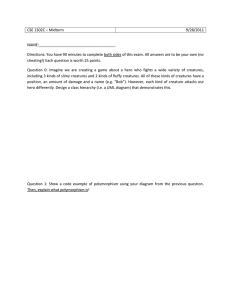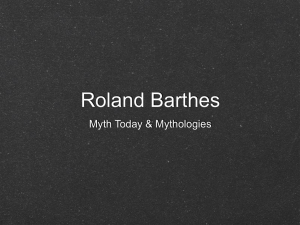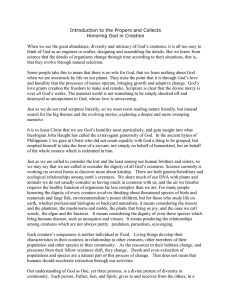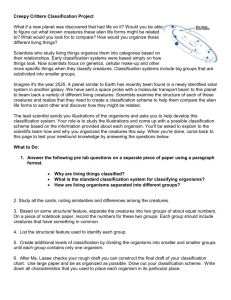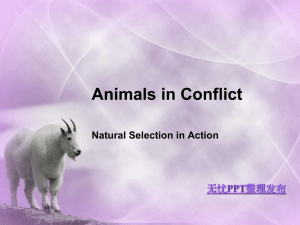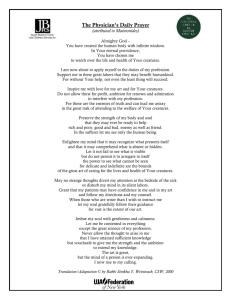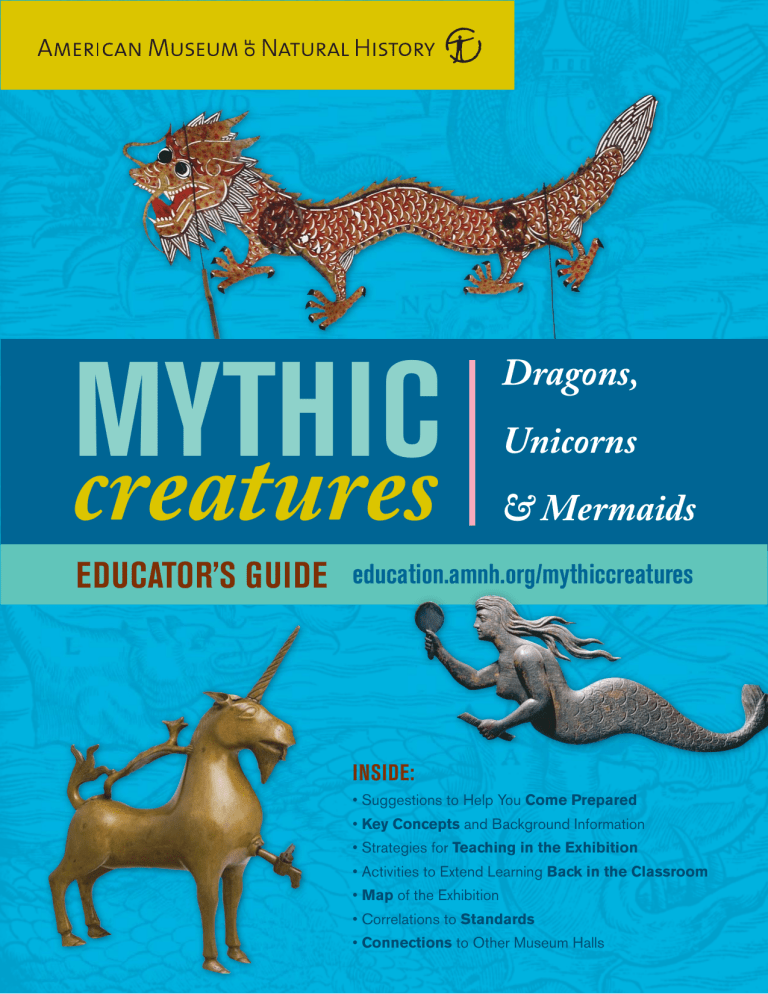
MYTHIC creatures EDUCATOR’S GUIDE Dragons, Unicorns & Mermaids education.amnh.org/mythiccreatures INSIDE: • Suggestions to Help You Come Prepared • Key Concepts and Background Information • Strategies for Teaching in the Exhibition • Activities to Extend Learning Back in the Classroom • Map of the Exhibition • Correlations to Standards • Connections to Other Museum Halls key CONCEPTS You can connect Mythic Creatures: Dragons, Unicorns, and Mermaids to your curriculum using these key concepts. They convey the main educational themes of the exhibition. Mythic Creatures Teach Us About Cultures Around the World Stories about mythic creatures embody belief systems, identity, moral codes, impressions of the natural world, and other aspects of humanity. As cultures change over time, the qualities of their mythic creatures can change, too. Therefore, we can study these creatures to learn about the history and evolution of cultures both ancient and modern. Kappa Cell Phone Dangle and Mask, Japan In early legends, the kappa lured children underwater to their deaths. Modern society softens the kappa’s original meaning, depicting it as cute and friendly—and far more fitting for children’s toys, movies, and books. Many Mythic Creatures Reflect Attempts to Describe the Natural World Mythic creatures can offer perspective on how scientific discovery changes over time. Before formal scientific methods came about, a fleeting glimpse of an animal or a finding of unfamiliar bones was often enough to confirm a being’s existence. Indeed, many mythic creatures are bizarre assemblages of parts of real animals. As methods for scientific observation and interpretation evolved, it became clear which animals exist in nature—and which are mythical. Pegasus Sculpture, US Pegasus was a loyal companion to heroes from Greek myths and remains a popular figure today. WHAT IS A MYTHIC CREATURE? Dragons, unicorns, mermaids… and bunyips, rocs, cyclopes, and more. Mythic creatures are fantastic beings—some familiar, others unusual—that take shape through human creativity. They enchant, terrify, and amuse. Their forms and meanings are as diverse as their cultural origins. Ultimately, mythic creatures serve as symbols of the human experience. That the often very ancient stories about these beings endure today is a testament to their powerful imagery and broad appeal in cultures around the world. Mythic Creatures Are a Medium of Cultural Interaction When people from different cultures interact, they often blend and borrow myths, stories, and images. This cultural exchange can explain why numerous cultures have mythic creatures that appear similar. Some even retain similar meanings. Lasirèn Sequined Flag, Haiti Many mermaids from around the world carry a comb and mirror. That detail was passed from European to African and Caribbean cultures. Mythic Creatures Take Shape Through Human Imagination Mythic creatures are evidence of the uniquely human capacity for symbolic expression: the ability to express abstract thoughts about our world using symbols in language, art, and music. Cultures Keep Mythic Creatures Alive Through Art and Literature The narratives of mythic creatures frequently appear in literature, oral traditions, music, dance, drama, celebrations, and many other art forms. These powerful stories continue to resonate with us and persist as artists reinterpret them over and over. Knowing more about mythic creatures can help us interpret their symbolic use in art and literature. Parade Dragon, China Asian dragons have sweeping powers. They breathe clouds, move the seasons, and control the waters. These venerated creatures are also a symbol of imperial rule. COME PREPARED Review this guide prior to your visit to the exhibition. In addition, go to education.amnh.org/mythiccreatures for an in-depth description of the exhibition, activities, book and web lists, and information about planning your visit. WORDS TO KNOW Class Discussion Before you visit the exhibition, let students know they’ll be able to explore many kinds of mythic creatures from different cultures and time periods. Read aloud the sidebar “What is a mythic creature?” and discuss the Key Concepts with students. To continue the dialogue, ask: Become familiar with the language of the exhibition • What mythic creatures have you encountered in books, artwork, television, video games, comics, and other media? List them. • culture: sum total of ways of living practiced by a group of human beings and transmitted from one generation to another • What do you know about these creatures? • Do these creatures have symbolic meaning? Solicit examples. • evidence: observations or other materials that support ideas, concepts, or scientific hypotheses • hoax: something intended to deceive; fraud • identity: the qualities and characteristics a person or group uses to describe who they are • imagination: the ability to form images and ideas in the mind, especially things never seen or experienced directly • interpret: to translate or explain • legend: an unverifiable story handed down by tradition and popularly accepted as having some basis in history • mythic: having supernatural or extraordinary qualities; often associated with traditional or legendary stories • representation: the visible form of an idea or concept • ritual: any practice or pattern of behavior repeated in a prescribed manner including but not restricted to religious rites • stylize: to give something a distinctive artistic or cultural style Your visit to the exhibition can be correlated to the national standards listed below. Additional correlations to New York State and City standards can be found at education.amnh.org/mythiccreatures. National Content Area Social Studies Standards K–4 Standard 1: Culture; B: People from diverse cultural perspectives may interpret experiences differently; C: Language, stories, folktales, and artists serve as expressions of culture 5–8 Standard 1: Culture; B: People from diverse cultural perspectives and frames may interpret information and experiences differently; C: Language, literature, the arts, and other artifacts, traditions, beliefs, and behaviors contribute to the development and transmission of culture 9–12 Standard 1: Culture; C: Apply an understanding of culture as an integrated whole; D: Compare and analyze societal patterns for preserving and transmitting culture National Science Education Standards K–4 A1: Ask a question about objects, organisms, and events in the environment; G1: Science and technology have been practiced by people for a long time 5–8 A2: Current scientific knowledge and understanding guide scientific investigations 9–12 A2: Scientific explanations must abide by the rules of evidence; it must be open to questions and be based on historical and current scientific knowledge; G3: The historical perceptive of scientific explanations demonstrates how scientific knowledge changes by evolving over time • symbol: a material object representing something visible or invisible; a characteristic mark used to represent something National English Language Arts Standards • traits: distinguishing characteristics or qualities National Standards in the Arts • witness: to be present at an occurrence; a spectator or bystander All grades 1: Reading for perspective; 2: Understanding the human experience; 3: Multi-cultural understanding All grades 3: Choosing and evaluating a range of subject matter, symbols, and ideas; 4: Understanding the visual arts in relation to history and cultures TEACHING in the exhibit Use this teaching tour of eight recommended stops to explore the Key Concepts. Refer to the Map of the Exhibition to find locations. Students can also explore the exhibition independently or in small groups with a field journal. dragon tour: Dragons appear on pavilions in the land, water, and air realms as well as in a room at the end of the exhibition. The dragon pavilion stops highlighted below, along with the dragon room, can be followed as an alternative tour. water realm Early Scientific Texts and Map Have students look at the sea monsters in these 16th-century books. Mention that the ocean was less explored then than it is today. Ask: • What do you think people thought about the sea and its inhabitants at that time in history? Mermaid Figurehead, Mami Wata Paintings, and Haitian Vodou Flags All mermaids are half fish, half human, but their depictions vary with local mythology and legend. Have students compare these mermaids from three different regions of the world. Ask: • Can you find the unique elements that differentiate European, African, and Caribbean mermaids? • Why do you think these mermaids look so similar? water dragon pavilion Have students examine the Chinese dragon shadow puppets. What do these puppets suggest about the meanings dragons have in Chinese culture? Mami Wata Painting, Africa land realm Dwarf Elephant Skull (Cyclops Section) Fossilized skulls of dwarf elephants are still found where the one-eyed cyclops was said to roam. Invite students to observe the skull and imagine stumbling upon it on an eroding hillside. Ask: • Why do you think the ancient Greeks may have thought skulls like this belonged to one-eyed giants? • What is this actually a skull of? • What features tell you it belonged to a small elephant? Barong Ket Costume The Barong Ket comes to life in costume performances that involve whole communities. Have students study the costume and pictures. Ask: • What aspects of human life are portrayed during the Barong performances? How do the performances help communities? • What animal(s) do you think this Barong resembles? What does the costume tell you about the Barong? land dragon pavilion Have students observe the statue of St. George slaying a dragon. What does this statue suggest about the meanings dragons have in European cultures? air realm Garuda Display The mythic bird-creature Garuda originated in Hindu custom, then diversified throughout Asia. Artistic interpretations of Garuda vary with medium and local cultural style. Have students look closely at the different Garuda figurines. Ask: • What features are shared? What features differ? • What is each Garuda doing? What do Garuda’s interactions with other beings tell you about this creature? Haast’s Eagle Talon (Roc Section) Sometimes scientists find evidence that hints at the possible origins of legendary creatures. Around the world there are many different stories of enormous birds. The Maori people of New Zealand tell stories about a giant eagle. Have students look at the illustration of a Haast’s eagle attacking moas. Then have them touch and think about the cast of a talon from an extinct Haast’s eagle. Ask: • What does evidence like this talon tell you about the possible origins of some air dragon pavilion mythic creatures? Have students examine the carved stone head of Quetzalcoatl. • Do you think the Haast’s What does this carving suggest about the meanings dragons eagle is still living today? have in Aztec and Mayan cultures? Why or why not? dragon room Ethiopian Illustrated Text European dragons are usually depicted as serpentlike creatures. St. George was a legendary dragon slayer and became a popular symbol of Christian faith. Ask: • How is St. George interacting with the dragon in this illustration? • What does the dragon look like? • What is it about this dragon’s appearance that makes it a symbol of evil? Chinese Dragon Robe Asian dragons are portrayed as benevolent creatures and divine bringers of rain. Robes like this were worn by Chinese emperors. Its symbolic decorations show dragons in a watery landscape. Ask: • What is depicted on this robe? • Why do you think Chinese emperors were associated with dragons? Explore Mythic Creatures with a Field Journal Working independently or in small groups, have students choose one of these three open-ended investigations. You can download a PDF of these investigations at education.amnh.org/ mythiccreatures. 1. Discover a Creature 2. Animal I.D. 3. Different Dragons Find a creature that is unfamiliar to you. Record the name and age of an object that depicts this creature, the culture it is associated with, where it was found, and what it is made of. Describe and draw it. Why did you choose this creature? Are there any similarities between this creature and other mythic creatures that you were already familiar with? Pick a creature in the exhibition. Record the name and age of an object that depicts this creature, the culture it is associated with, where it was found, and what it is made of. List the real animal parts that make up this creature. What are the traits of these animals? What might these traits tell you about the behavior and meaning of this mythic creature? Find one dragon from an Asian culture and one dragon from a European culture. Record the name and age of an object that depicts each dragon, the culture it is associated with, where it was found, and what it is made of. Describe how the dragons are shown. Do dragons mean different things to Asian and European cultures? How do you know? back in the CLASSROOM ACTIVITIES All Subjects English Language Arts • Design a Mythic Creature (K-12): Have students develop a mythic creature of their own design. They should consider: What inspired its attributes? Does this creature have a message? How is it relevant to the students’ world—or the world at large? Have students draw and label a picture of it. Older students may want to express their creature through a cartoon strip, book jacket, coat of arms, costume, or other media. • Read a Story (K-12): Have students read stories, comics, or manga that feature mythic creatures. Explore the creature’s attributes, symbolism, and role in the story. Is this creature based on ancient legend? Older kids may want to compare and contrast depictions of European and Asian dragons. Recommended books are available on our website. • Mythic “Telephone” (K–8): Mythic creatures can change as artists reinterpret them. They can also change by word of mouth. To explore those concepts, try this: Line up students and show the first an image of an unusual animal. He/she should describe (but not name) it in the next student’s ear, and so on. The last student in line can draw it on the board. Compare the drawing to the original image. Social Studies Visual and Performing Arts • Create a Mythic Creature Mask or Puppet (K-12): Have students design a mask or puppet of a creature they saw at the exhibition. DISCUSS THE EXHIBITION Extend your visit to the Museum with a class discussion. Below are some conversation starters. • Modern Mythic Creatures (3-8): Have students choose creatures visible in popular culture (e.g. movies, mascots, ads, video games, comics, anime) and research their mythic origins. What did they symbolize in the past? How and why are these symbols still used today? • What mythic creatures were new to you? Did any surprise you? • Interview an Adult (6-12): Students can interview an elder to explore what mythic creatures he or she was aware of as a child. What did this creature mean to him or her? Is it still “in circulation”? Do the mythic creatures lend any insight on the cultural background of this person? • Think of a favorite book or movie with a mythic creature. Compare how it was portrayed in the book or movie versus how it was portrayed in the exhibition. Science • Fleeting Impressions (K-12): Students can experience how difficult it can be to describe an animal based on one fleeting observation. Walk around the class with a photo of an unusual animal so each student observes it for just a few seconds. Take the image away, and have students describe the animal in as much detail as possible. Compare student recollections to the picture. • How can learning about mythic creatures and their origins help us understand people and cultures around the world? • How are mythic creatures depicted in our culture today? What do they tell you about the world we live in? ONLINE ACTIVITIES Visit education.amnh.org/mythiccreatures: Students can explore mermaid migration; research early explorers and the real animals they mistakenly identified as mythic creatures; investigate mysterious modern species; and interpret unfamiliar bones. Visit ology.amnh.org/mythiccreatures: Students can investigate an interactive map; explore a mythic creatures photo gallery; design a creature mask or puppet; download stationery; and create OLogy projects. CREDITS Mythic Creatures: Dragons, Unicorns & Mermaids is organized by the American Museum of Natural History, New York (www.amnh.org), in collaboration with The Field Museum, Chicago; Canadian Museum of Civilization, Gatineau; Australian National Maritime Museum, Sydney; and Fernbank Museum of Natural History, Atlanta. Mythic Creatures: Dragons, Unicorns & Mermaids is proudly supported by This Educator’s Guide is produced by the Education Department at the American Museum of Natural History. © 2007 American Museum of Natural History. All Rights Reserved. PHOTO CREDITS: Cover — dragon shadow puppet, AMNH/D. Finnin; aquamanile unicorn, Metropolitan Museum of Art; mermaid weathervane, © Shelburne Museum, Shelburne, Vermont Key Concepts — kappa cell phone dangle and mask, AMNH; Lasirèn sequined flag, Chinese parade dragon, AMNH/D. Finnin; Pegasus sculpture, A. Ressetti Teaching in the Exhibition — early scientific text, dwarf elephant skull, Garuda figurine, Chinese dragon robe, AMNH/D. Finnin; Barong Ket costume, AMNH/R. Mickens; Mami Wata painting, talon, Ethiopian illustrated text, AMNH Connections — Hall of Asian Peoples, AMNH/ L. Lowell; Hall of Pacific Peoples, AMNH/R. Mickens; Spitzer Hall of Human Origins, AMNH/D. Finnin creatures MYTHIC amnh.org/mythiccreatures Dragons, Unicorns & Mermaids > MAP of the exhibition exit Explore some of the world’s most enduring mythic creatures. 17 water realm 1. Kraken and Sea Monsters 2. Bunyip and Mishepishu 3. Kappa and Ahuizotl 4. Nasca Killer Whale 5. European Mermaids, Lasirèn, Mami Wata, Feejee Mermaid, and Yawkyawk 16 dragon 14 15 13 land realm 12 10 air land 11 9 8 6. Giants, Cyclops, and Griffin 7. Asian and European Unicorns 8. Barong 9. Chupacabra 10. Humanlike Creatures air realm 11. Sphinx and Pegasus 12. Roc 13. Garuda and Naga 14. Phoenix 15. Tengu 7 6 dragon room 4 5 water 16. Asian Dragons 17. European Dragons 1 3 KEY i Interactive Station Model of creature in midair > 2 entrance © 2007 American Museum of Natural History. All Rights Reserved. MYTHIC creatures Dragons, Unicorns & Mermaids amnh.org/mythiccreatures CONNECTIONS to other museum halls Continue your exploration of mythic creatures around the Museum with these specimens and artifacts. Hall of Asian Peoples (2nd floor) Hall of Pacific Peoples (3rd floor) Dragons and other mythic creatures abound in this hall. Some places to look: In the Traditional China section, Chinese gods ride dragons in the temple display, and dragons with various forms and meanings appear in the Taoism display. The theater case features a splendid dragon-adorned actor’s robe. Look for a metal vessel with a dragon handle and spout in the Tibet section. Many displays in this hall contain fantastic creatures. In the Indonesia section, look for the creaturelike masks and puppets used for performances. Spot creatures in the hanging textiles to the left of the puppets. In the Solomon Islands section, two wooden figures are half human, half shark. And observe a stunning Balinese paper calendar adorned with many interesting beings in the Margaret Mead in the Field section. Milstein Hall of Ocean Life (1st floor) Spitzer Hall of Human Origins (1st floor) Follow the hall to the rear section to explore how we as humans are unique in the ability to express ourselves through symbols in art, music, and language. Pause on the mezzanine before descending into the hall. Look down and left. You’ll see a case with several dolphins piercing the ocean’s surface. Early sailors may have mistaken a similar scene as many parts of a single sea serpent emerging from the water. Near the dolphin case is a giant squid tussling with a sperm whale. Hall of Biodiversity (1st floor) A full-scale model of the giant squid hangs from the ceiling. Only recently were scientists able to observe this real-life “sea monster” in its natural habitat. Hall of Ornithischian Dinosaurs (4th floor) Look at the growth series of Protoceratops skulls along one wall. Behind you are two adults with a nest of eggs. Fossils like these may have inspired the myth of the griffin. Look for skeletal features that appear griffinlike. © 2007 American Museum of Natural History. All Rights Reserved.
